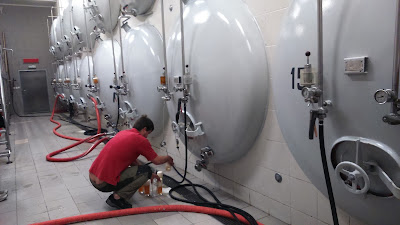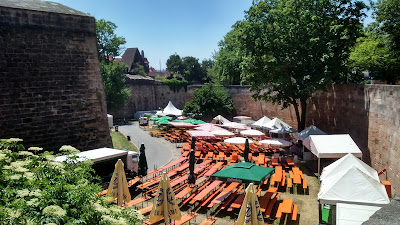 |
| Fränkische Bierfest |
I really enjoyed EN’s company. He encouraged me to converse with him in German, so the event provided a good opportunity to practise both my listening and conversational skills. The festival itself was great fun and there were lots of interesting bees to try, but it did get very busy and rather crowded; and this was on the Friday afternoon! Saturday would no doubt prove even busier, so at EN’s suggestion I decided it would be nice to get out of the city and see some of the Franconian countryside.
Before we went our separate ways, we had sketched out a rough plan that I would head out towards Forchheim; either for a visit to the Kellerwald (home in around six week’s time to Annafest), or make for the Kellers on the Kreuzberg, between Stiebarlimbach and Schnaid. My son and I had done this a couple of years’ previously, although we had confined our visit to just one Keller; namely the one belonging to Roppelts Brauerei, just behind the brewery itself in Stiebarlimbach. It was here that we missed the last bus back to Forchheim and had ended up hitch-hiking, but that’s another story, but come the Saturday it seemed a good idea to head in that direction and see what transpired.
I had been in email and text communication with EN, and following his suggestion I purchased a Tages Ticket Plus, which not only covered all zones of the extended Nuremberg public transport area for both rail and bus services, but was also valid for entire weekend. At €18 it was an absolute bargain, as I was able to use the ticket the following day, to visit Bamberg and also to get myself to the airport in the evening for my flight home.
 |
| Brauerei Roppelt |
 The bus ride up to Stiebarlimbach brought back memories of a similar journey undertaken almost two years previously. It was a similarly hot day, and the bus had several passengers who alighted at the village centre stop, right opposite the Roppelt Brewery; no doubt bound, as I was, for the Keller. This time I checked the bus departure times carefully, as I didn’t want a repeat of my previous experience. That done, I walked through the brewery yard, before turning left towards the woods. It was already very hot and sticky, and although it was only a short walk, I was glad of the shade and a stoneware mug of nice cool Kellerbier when I arrived at Roppelt’s.
The bus ride up to Stiebarlimbach brought back memories of a similar journey undertaken almost two years previously. It was a similarly hot day, and the bus had several passengers who alighted at the village centre stop, right opposite the Roppelt Brewery; no doubt bound, as I was, for the Keller. This time I checked the bus departure times carefully, as I didn’t want a repeat of my previous experience. That done, I walked through the brewery yard, before turning left towards the woods. It was already very hot and sticky, and although it was only a short walk, I was glad of the shade and a stoneware mug of nice cool Kellerbier when I arrived at Roppelt’s. |
| Brauerei Rittmayer - Aisch |
This first stop was the tiny village of Adelsdorf-Aisch; set on a hill overlooking the River Aisch, and its surrounding meadows. On the edge of the village, and overlooking the flatlands is the Brauerei & Gasthaus Rittmayer Aisch. EN informed me that there are three breweries in the region, all sharing the Rittmayer name, but the one in Aisch is the smallest. Just up from the pub and the brewery was the village church, making up that classic combination of pub and church which is so common in English villages as well.
 The pub has its own small, shady beer garden, just across the road and it was this we made for. A small hut in the corner is often used to serve beer straight from the cask, but EN said that as the day was so hot, the management would not wish to leave the beer there for any length of time. It didn’t matter, as our arrival had been noted and the Kellnerin was soon over at our table taking our order. We both went for the Hausbrauer-Bier and to eat the obvious choice was the local white asparagus, known in German as Spargel. This was my first experience of Spargel, and wrapped in slices of ham and served with boiled potatoes, it was delicious. The beer was good too, and sitting there under the shade of the chestnut tree, against the backdrop of the pub, brewery and the splendid view was really as good as things can get, so in some ways it was a shame we had to move on.
The pub has its own small, shady beer garden, just across the road and it was this we made for. A small hut in the corner is often used to serve beer straight from the cask, but EN said that as the day was so hot, the management would not wish to leave the beer there for any length of time. It didn’t matter, as our arrival had been noted and the Kellnerin was soon over at our table taking our order. We both went for the Hausbrauer-Bier and to eat the obvious choice was the local white asparagus, known in German as Spargel. This was my first experience of Spargel, and wrapped in slices of ham and served with boiled potatoes, it was delicious. The beer was good too, and sitting there under the shade of the chestnut tree, against the backdrop of the pub, brewery and the splendid view was really as good as things can get, so in some ways it was a shame we had to move on. |
| Spargel with potatoes and ham |
It was a bit of a drive to the next pub and brewery; a drive which took us around a stately home. Later, when I looked at a map, I saw that we had travelled a fair distance north and were almost parallel with Bamberg, although quite a way over to the west. The village in question was Mönchsambach; a much larger settlement than Aisch, and with a substantial brewery in the form of Brauerei Zehendner. We drove into the brewery courtyard and parked the car. The place seemed very much asleep; hardly surprising given the thermometer had now reached 30˚. EN thought it would be a case of self-service, so we entered the large pub on the opposite side of the courtyard to the brewery and ordered some beer. A half litre for me and a Schnitt for EN.
 |
| Brauerei Zehender - Mönchsambach |
 |
| View from Schmausenkeller |
 |
| Schmausenkeller |
The final stop on our tour was the Schmausenkeller, which sells beer from Brauerei Müller who brew in the nearby village of Reundorf. Like the previous Keller, Schmausenkeller is set in glorious countryside, with wide-ranging views. However, it is a much larger, operation, with the serving area, by the side of the road (we could see an old Keller, built for beer storage set into the side of the hill) leading up to a substantial three-story building, which houses bars and a restaurant, and which allows for all-weather service. However, given the fine, warm weather, like us, virtually all the Keller’s patrons were sat outside, enjoying the beer and the views.
 |
| Enjoying a nice cool mug of Kellerbier |
EN dropped me in Hirschaid right outside the Brauerei Kraus Gasthof, where he said I would get a decent meal, plus some good beer. I thanked him profusely before he drove off, for providing me with such an enjoyable tour of the Steigerwald and for such an excellent day out. During the time we spent together, we had conversed practically all the time in German which, for me, was a great opportunity to practise.
 |
| Brauerei Kraus - Hirschaid |
EN was right about Brauerei Kraus. There was a beer garden at the rear of the brewery-pub complex, with a self-service area which reminded me of beer gardens in southern Bavaria, and Munich in particular. I chose a substantial looking Schnitzel, which was cooked whilst I waited, plus a half litre mug of Kraus Kellerbier to wash it down.
 |
| Beer garden at Brauerei Kraus |
I found a free table at the side of the garden and sat down to enjoy my meal and indulge in a spot of people watching. It was early on Saturday evening; the place was busy, and I guessed that some of the customers had been there for some time (one was leaning back on his chair, fast asleep!). There were plenty of families there too, enjoying the pleasant warm evening. I got stuck into my food, whilst enjoying the cool, hoppy beer. I was tempted to have another, but after I found that I too was starting to drift off, decided against the idea.
 |
| Schnitzel, chips plus Kellerbier |
I wandered along to the station and caught the next train back to Nuremberg. I got a seat without any problem, but the train started to fill up as we headed towards our destination. I didn’t really notice this until we reached Fürth, as this time I really did nod off!
Footnote: a big thank-you to fellow beer blogger, Tandleman for
putting me in touch with Erlangernick

































